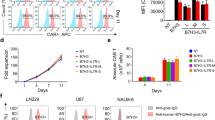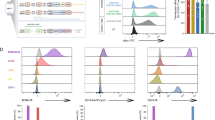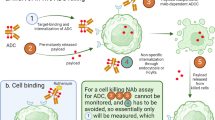Abstract
CD22 is a B-cell surface antigen which is highly expressed in cancerous B-cell lineages. Anti-CD22 antibodies are currently under focus as promising biologics against hematologic B-cell malignancies. Herein, we introduce a novel active recombinant anti-CD22 scFv.Bim fusion protein for targeting this cancerous antigen. An expression cassette encoding anti-CD22 scFv.Bim fusion protein was expressed in Pichia pastoris. The binding ability, cytotoxicity, and apoptotic activity of the purified recombinant protein against CD22+ Raji cell line were assessed by flow cytometry, microscopy, and MTT assay. Using bioinformatics, the 3D structure of the fusion protein and its interaction with CD22 were assessed. The in vitro binding analysis by immunofluorescence microscopy and flow cytometry demonstrated the specific binding of scFv.Bim to CD22+ Raji cells but not to CD22− Jurkat cells. MTT data and Annexin V/PI flow cytometry analysis confirmed the apoptotic activity of anti-CD22 scFv.Bim against Raji cells but not Jurkat cells. In silico analysis also revealed the satisfactory stereochemical quality of the 3D model and molecular interactions toward CD22. This novel recombinant anti-CD22 scFv.Bim fusion protein could successfully deliver the pro-apoptotic peptide, BIM, to the target cells and thus nominates it as a promising molecule in treating B-cell malignancies.










Similar content being viewed by others
Data Availability
All data generated or analyzed during this study are included in the article (and its supplementary information files).
References
Sant, M., Allemani, C., Tereanu, C., De Angelis, R., Capocaccia, R., Visser, O., … Steward, J. (2010). Incidence of hematologic malignancies in Europe by morphologic subtype: Results of the HAEMACARE project. Blood, 116(19), 3724–3734.https://doi.org/10.1182/blood-2010-05-282632
Herrera, A. F., & Molina, A. (2018). Investigational antibody–drug conjugates for treatment of B-lineage malignancies. Clinical Lymphoma, Myeloma and Leukemia, 18(7), 452-468.e4. https://doi.org/10.1016/j.clml.2018.05.006
Sung, H., Ferlay, J., Siegel, R. L., Laversanne, M., Soerjomataram, I., Jemal, A., & Bray, F. (2021). Global cancer statistics 2020: GLOBOCAN estimates of incidence and mortality worldwide for 36 cancers in 185 countries. CA: A Cancer Journal for Clinicians, 71(3), 209–249. https://doi.org/10.3322/caac.21660
Sullivan-Chang, L., O’Donnell, R. T., & Tuscano, J. M. (2013). Targeting CD22 in B-cell malignancies: Current status and clinical outlook. BioDrugs, 27(4), 293–304. https://doi.org/10.1007/s40259-013-0016-7
Von Mehren, M., Adams, G. P., & Weiner, L. M. (2003). Monoclonal antibody therapy for cancer. Annual Review of Medicine, 54, 343–369. https://doi.org/10.1146/annurev.med.54.101601.152442
Krauss, J., Arndt, M. A. E., Vu, B. K., Newton, D. L., & Rybak, S. M. (2005). Targeting malignant B-cell lymphoma with a humanized anti-CD22 scFv-angiogenin immunoenzyme. British Journal of Haematology, 128(5), 602–609. https://doi.org/10.1111/j.1365-2141.2005.05356.x
Alderson, R. F., Kreitman, R. J., Chen, T., Yeung, P., Herbst, R., Fox, J., & Pastan, I. (2009). CAT-8015: A second-generation pseudomonas exotoxin a-based immunotherapy targeting CD22-expressing hematologic malignancies. Clinical Cancer Research, 15(3), 832–839. https://doi.org/10.1158/1078-0432.CCR-08-1456
Ereño-Orbea, J., Sicard, T., Cui, H., Mazhab-Jafari, M. T., Benlekbir, S., Guarné, A., … John L. Rubinstein1, 2, 4 & Jean-Philippe Julien. Molecular basis of human CD22 function and therapeutic targeting. , 8 Nature Communications (2017). https://doi.org/10.1038/s41467-017-00836-6
Cesano, A., & Gayko, U. (2003). CD22 as a target of passive immunotherapy. Seminars in Oncology, 30(2), 253–257. https://doi.org/10.1053/sonc.2003.50057
Kreitman, R. J., & Pastan, I. (2011). Antibody fusion proteins: Anti-CD22 recombinant immunotoxin moxetumomab pasudotox. Clinical Cancer Research, 17(20), 6398–6405. https://doi.org/10.1158/1078-0432.CCR-11-0487
Mikiewicz, D., Łukasiewicz, N., Zieliński, M., Cecuda-Adamczewska, V., Bierczyńska-Krzysik, A., Romanik-Chruścielewska, A., & Kęsik-Brodacka, M. (2020). Bacterial expression and characterization of an anti-CD22 single-chain antibody fragment. Protein Expression and Purification, 170(November 2019). https://doi.org/10.1016/j.pep.2020.105594
Shah, N. N., & Sokol, L. (2021). Targeting CD22 for the treatment of B-cell malignancies. ImmunoTargets and Therapy, 10, 225–236. https://doi.org/10.2147/itt.s288546
Lanza, F., Maffini, E., Rondoni, M., Massari, E., Faini, A. C., & Malavasi, F. (2020). CD22 expression in B-cell acute lymphoblastic leukemia: Biological significance and implications for inotuzumab therapy in adults. Cancers, 12(2), 1–14. https://doi.org/10.3390/cancers12020303
Najmeh Zarei & Behrouz Vaziri & Mohammad Ali Shokrgozar & Reza Mahdian & Ramin Fazel & Vahid Khalaj. (2014). High efficient expression of a functional humanized single-chain variable fragment (scFv) antibody against CD22 in Pichia pastoris. Appl Microbiol Biotechnol. Retrieved from https://link.springer.com/content/pdf/https://doi.org/10.1007/s00253-014-6071-2.pdf
Agha Amiri, S., Shahhosseini, S., Zarei, N., Khorasanizadeh, D., Aminollahi, E., Rezaie, F., … Khalaj, V. (2017). A novel anti-CD22 scFv–apoptin fusion protein induces apoptosis in malignant B-cells. AMB Express, 7(1). https://doi.org/10.1186/s13568-017-0410-5
Vallet-Courbin, A., Larivière, M., Hocquellet, A., Hemadou, A., Parimala, S. N., Laroche-Traineau, J., …, Noubhani, A. (2017). A recombinant human anti-platelet SCFV antibody produced in pichia pastoris for atheroma targeting. PLoS ONE, 12(1), 1–18.https://doi.org/10.1371/journal.pone.0170305
Montoliu-Gaya, L., Esquerda-Canals, G., Bronsoms, S., & Villegas, S. (2017). Production of an anti-Aβ antibody fragment in Pichia pastoris and in vitro and in vivo validation of its therapeutic effect. PLoS ONE, 12(8), 1–19. https://doi.org/10.1371/journal.pone.0181480
Yokota, T., Milenic, D. E., Whitlow, M., & Schlom, J. (1992). Rapid Tumor Penetration of a Single-Chain Fv and Comparison with Other Immunoglobulin Forms. Cancer Research, 52(12), 3402–3408.
Krauss, J., Arndt, M. A. E., Martin, A. C. R., Liu, H., & Rybak, S. M. (2003). Specificity grafting of human antibody frameworks selected from a phage display library: Generation of a highly stable humanized anti-CD22 single-chain Fv fragment. Protein Engineering, 16(10), 753–759. https://doi.org/10.1093/protein/gzg096
Arndt, M. A. E., Krauss, J., Schwarzenbacher, R., Vu, B. K., Greene, S., & Rybak, S. M. (2003). Generation of a highly stable, internalizing anti-CD22 single-chain Fv fragment for targeting non-Hodgkin’s lymphoma. International Journal of Cancer, 107(5), 822–829. https://doi.org/10.1002/ijc.11451
Lim, B., Greer, Y., Lipkowitz, S., & Takebe, N. (2019). Novel apoptosis-inducing agents for the treatment of cancer, a new arsenal in the toolbox. Cancers, 11(8), 1–39. https://doi.org/10.3390/cancers11081087
Galluzzi, L., Vitale, I., Aaronson, S. A., Abrams, J. M., Adam, D., Agostinis, P., …, Kroemer, G. (2018). Molecular mechanisms of cell death: Recommendations of the Nomenclature Committee on Cell Death 2018. Cell Death and Differentiation, 25(3), 486–541.https://doi.org/10.1038/s41418-017-0012-4
Reed, J. C. (2002). Apoptosis-based therapies. Nature Reviews Drug Discovery. https://doi.org/10.1038/nrd726
Delgado-Soler, L., Pinto, M., Tanaka-Gil, K., & Rubio-Martinez, J. (2012). Molecular determinants of Bim(BH3) peptide binding to pro-survival proteins. Journal of Chemical Information and Modeling, 52(8), 2107–2118. https://doi.org/10.1021/ci3001666
Gross, A., McDonnell, J. M., & Korsmeyer, S. J. (1999). BCL-2 family members and the mitochondria in apoptosis. Genes and Development, 13(15), 1899–1911. https://doi.org/10.1101/gad.13.15.1899
Ren, D., Tu, H. C., Kim, H., Wang, G. X., Bean, G. R., Takeuchi, O., …, Cheng, E. H. Y. (2010). BID, BIM, and PUMA are essential for activation of the BAX- and BAK-dependent cell death program. Sciencbactere, 330(6009), 1390–1393.https://doi.org/10.1126/science.1190217
Harada, H., & Grant, S. (2012). Targeting the regulatory machinery of BIM for cancer therapy. Critical Reviews in Eukaryotic Gene Expression, 22(2), 117–129. https://doi.org/10.1615/CritRevEukarGeneExpr.v22.i2.40
O’Connor, L., Strasser, A., O’Reilly, L. A., Hausmann, G., Adams, J. M., Cory, S., & Huang, D. C. S. (1998). Bim: A novel member of the Bcl-2 family that promotes apoptosis. EMBO Journal, 17(2), 384–395. https://doi.org/10.1093/emboj/17.2.384
Bouillet, P., Zhang, L. C., Huang, D. C. S., Webb, G. C., Bottema, C. D. K., Shore, P., …, Adams, J. M. (2001). Gene structure, alternative splicing, and chromosomal localization of pro-apoptotic Bcl-2 relative Bim. Mammalian Genome, 12(2), 163–168. https://doi.org/10.1007/s003350010242
Merino, D., Kelly, G. L., Lessene, G., Wei, A. H., Roberts, A. W., & Strasser, A. (2018, December 10). BH3-mimetic drugs: Blazing the trail for new cancer medicines. Cancer Cell. Cell Press. https://doi.org/10.1016/j.ccell.2018.11.004
Shroff, E. H., Snyder, C. M., Budinger, G. R. S., Jain, M., Chew, T. L., Khuon, S., …, Chandel, N. S. (2009). BH3 peptides induce mitochondrial fission and cell death independent of BAX/BAK. PLoS ONE, 4(5), 5646.https://doi.org/10.1371/journal.pone.0005646
Akiyama, T., Dass, C. R., & Choong, P. F. M. (2009). Bim-targeted cancer therapy: A link between drug action and underlying molecular changes. Molecular Cancer Therapeutics. https://doi.org/10.1158/1535-7163.MCT-09-0685
Kim, B. W., Cho, H., Ylaya, K., Kitano, H., Chung, J. Y., Hewitt, S. M., & Kim, J. H. (2017). Bcl-2-like protein 11 (BIM) expression is associated with favorable prognosis for patients with cervical cancer. Anticancer Research, 37(9), 4873–4879. https://doi.org/10.21873/anticanres.11896
M.Obeid, T. A. T.-A. A. H. (2006). Sphingosine kinase-1 is cleaved by cathepsin B in vitro: Identification of the initial cleavage sites for the protease, 580(26), 6047–6054. https://doi.org/10.1016/j.febslet.2006.09.070
Kern, H. B., Srinivasan, S., Convertine, A. J., Hockenbery, D., Press, O. W., & Stayton, P. S. (2017). Enzyme-cleavable polymeric micelles for the intracellular delivery of proapoptotic peptides. Molecular Pharmaceutics, 14(5), 1450–1459. https://doi.org/10.1021/acs.molpharmaceut.6b01178
Blum, J. S., Fiani, M. L., & Stahl, P. D. (1991). Proteolytic cleavage of ricin A chain in endosomal vesicles. Evidence for the action of endosomal proteases at both neutral and acidic pH. Journal of Biological Chemistry, 266(33), 22091–22095. https://doi.org/10.1016/s0021-9258(18)54537-3
Copolovici, D. M., Langel, K., Eriste, E., & Langel, Ü. (2014). Cell-penetrating peptides: Design, synthesis, and applications. ACS Nano, 8(3), 1972–1994. https://doi.org/10.1021/nn4057269
Varkouhi, A. K., Scholte, M., Storm, G., & Haisma, H. J. (2011). Endosomal escape pathways for delivery of biologicals. Journal of Controlled Release, 151(3), 220–228. https://doi.org/10.1016/j.jconrel.2010.11.004
Laskowski, R. A., MacArthur, M. W., Moss, D. S., & Thornton, J. M. (1993). PROCHECK: A program to check the stereochemical quality of protein structures. Journal of Applied Crystallography, 26(2), 283–291. https://doi.org/10.1107/s0021889892009944
Williams, C. J., Headd, J. J., Moriarty, N. W., Prisant, M. G., Videau, L. L., Deis, L. N., …, Richardson, D. C. (2018). MolProbity: More and better reference data for improved all-atom structure validation. Protein Science, 27(1), 293–315.https://doi.org/10.1002/pro.3330
Colovos, C., & Yeates, T. O. (1993). Verification of protein structures: Patterns of nonbonded atomic interactions. Protein Science, 2(9), 1511–1519. https://doi.org/10.1002/pro.5560020916
Roland Lüthy, J. U. B., & D. E. (1992). Assessment of protein models with three-dimensional profiles. Nature, 356, 83–85. https://doi.org/10.1038/356083a0
Hebditch, M., Carballo-Amador, M. A., Charonis, S., Curtis, R., & Warwicker, J. (2017). Protein-Sol: A web tool for predicting protein solubility from sequence. Bioinformatics, 33(19), 3098–3100. https://doi.org/10.1093/bioinformatics/btx345
Walker, J. M. (2005). The Proteomics Protocols Handbook. In Springer.
Kozakov, D., Hall, D. R., Xia, B., Porter, K. A., Padhorny, D., Yueh, C., …, Vajda, S. (2017). The ClusPro web server for protein-protein docking. Nature Protocols, 12(2), 255–278.https://doi.org/10.1038/nprot.2016.169
Dunbar, J., Krawczyk, K., Leem, J., Baker, T., Fuchs, A., Georges, G., …, Deane, C. M. (2014). SAbDab: The structural antibody database. Nucleic Acids Research, 42(D1), 1140–1146.https://doi.org/10.1093/nar/gkt1043
Wallace, A. C., Laskowski, R. A., & Thornton, J. M. (1995). LIGPLOT: A program to generate schematic diagrams of protein-ligand interactions The LIGPLOT program automatically generates schematic 2-D representations of protein-ligand complexes from standard Protein Data Bank file input. Protein Engineering, 8(2), 127–134.
Xue, L. C., Rodrigues, J. P., Kastritis, P. L., Bonvin, A. M., & Vangone, A. (2016). PRODIGY: A web server for predicting the binding affinity of protein-protein complexes. Bioinformatics, 32(23), 3676–3678. https://doi.org/10.1093/bioinformatics/btw514
Abraham, M. J., Murtola, T., Schulz, R., Páll, S., Smith, J. C., Hess, B., & Lindah, E. (2015). Gromacs: High performance molecular simulations through multi-level parallelism from laptops to supercomputers. SoftwareX, 1–2, 19–25. https://doi.org/10.1016/j.softx.2015.06.001
Zhao, Z., Zheng, L., Chen, W., Weng, W., Song, J., & Ji, J. (2019). Delivery strategies of cancer immunotherapy: Recent advances and future perspectives. Journal of Hematology and Oncology, 12(1), 1–14. https://doi.org/10.1186/s13045-019-0817-3
Riley, R. S., June, C. H., Langer, R., & Mitchell, M. J. (2019). Delivery technologies for cancer immunotherapy. Nature Reviews Drug Discovery, 18(3), 175–196. https://doi.org/10.1038/s41573-018-0006-z
Goulet, D. R., & Atkins, W. M. (2020). Considerations for the design of antibody-based therapeutics. Journal of Pharmaceutical Sciences, 109(1), 74–103. https://doi.org/10.1016/j.xphs.2019.05.031
Kim, J. S., Jun, S. Y., & Kim, Y. S. (2020). Critical Issues in the development of immunotoxins for anticancer therapy. Journal of Pharmaceutical Sciences, 109(1), 104–115. https://doi.org/10.1016/j.xphs.2019.10.037
Govindaraju, A. (2006). Immunotoxins: A review of their use in cancer treatment. Journal of Stem Cells and Regenerative Medicine, 1(1), 31–36. https://doi.org/10.46582/jsrm.0101005
Holliger, P., & Hudson, P. J. (2005). Engineered antibody fragments and the rise of single domains. Nature Biotechnology, 23(9), 1126–1136. https://doi.org/10.1038/nbt1142
Malpiedi, L. P., Díaz, C. A., Nerli, B. B., & Pessoa, A. (2013). Single-chain antibody fragments: Purification methodologies. Process Biochemistry, 48(8), 1242–1251. https://doi.org/10.1016/j.procbio.2013.06.008
Shi, X., Karkut, T., Chamankhah, M., Alting-Mees, M., Hemmingsen, S. M., & Hegedus, D. (2003). Optimal conditions for the expression of a single-chain antibody (scFv) gene in Pichia pastoris. Protein Expression and Purification, 28(2), 321–330. https://doi.org/10.1016/S1046-5928(02)00706-4
Weinacker, D., Rabert, C., Zepeda, A. B., Figueroa, C. A., Pessoa, A., & Farías, J. G. (2013). Applications of recombinant Pichia pastoris in the healthcare industry. Brazilian Journal of Microbiology. https://doi.org/10.1590/S1517-83822013000400004
Cao, X., Yu, H., Chen, C., Wei, J., & Wang, P. (2015). Expression and characterization of recombinant humanized anti-HER2 single-chain antibody in Pichia pastoris for targeted cancer therapy. Biotechnology Letters, 37(7), 1347–1354. https://doi.org/10.1007/s10529-015-1804-6
Arias, C. A. D., Marques, D. de A. V., Malpiedi, L. P., Maranhão, A. Q., Parra, D. A. S., Converti, A., & Junior, A. P. (2017). Cultivation of Pichia pastoris carrying the scFv anti LDL (−) antibody fragment. Effect of preculture carbon source. Brazilian Journal of Microbiology, 48(3), 419–426. https://doi.org/10.1016/j.bjm.2016.11.009
Siegel, A. B., Goldenberg, D. M., Cesano, A., Coleman, M., & Leonard, J. P. (2003). CD22-directed monoclonal antibody therapy for lymphoma. Seminars in Oncology, 30(4), 457–464. https://doi.org/10.1016/S0093-7754(03)00240-9
DiJoseph, J. F., Popplewell, A., Tickle, S., Ladyman, H., Lawson, A., Kunz, A., …, Damle, N. K. (2005). Antibody-targeted chemotherapy of B-cell lymphoma using calicheamicin conjugated to murine or humanized antibody against CD22. Cancer Immunology, Immunotherapy, 54(1), 11–24.https://doi.org/10.1007/s00262-004-0572-2
Teo, E. C., & yuan, Chew, Y., & Phipps, C. (2016). A review of monoclonal antibody therapies in lymphoma. Critical Reviews in Oncology/Hematology, 97(August), 72–84. https://doi.org/10.1016/j.critrevonc.2015.08.014
Shor, B., Gerber, H. P., & Sapra, P. (2015, October 1). Preclinical and clinical development of inotuzumab-ozogamicin in hematological malignancies. Molecular Immunology. Mol Immunol. https://doi.org/10.1016/j.molimm.2014.09.014
Chevallier, P., Eugene, T., Robillard, N., Isnard, F., Nicolini, F., Escoffre-Barbe, M., …, Kraeber-Bodéré, F. (2015). 90Y-labelled anti-CD22 epratuzumab tetraxetan in adults with refractory or relapsed CD22-positive B-cell acute lymphoblastic leukaemia: A phase 1 dose-escalation study. The Lancet Haematology, 2(3), e108–e117.https://doi.org/10.1016/S2352-3026(15)00020-4
Lindén, O., Bates, A. T., Cunningham, D., Hindorf, C., Larsson, E., Cleton, A., … McNamara, C. (2021). Thorium-227-labeled anti-CD22 antibody (BAY 1862864) in relapsed/refractory CD22-positive non-Hodgkin lymphoma: A first-in-human, phase I study. Cancer Biotherapy and Radiopharmaceuticals, 00(00). https://doi.org/10.1089/cbr.2020.4653
Sausville, E., Headlee, D., Stetler-Stevenson, M., Jaffe, E., Solomon, D., Figg, W., …, Steinberg, S. (1995). Continuous infusion of the anti-CD22 immunotoxin IgG-RFB4-SMPT-dgA in patients with B-cell lymphoma: A phase I study. Blood, 85(12), 3457–3465.https://doi.org/10.1182/blood.V85.12.3457.bloodjournal85123457
Bachanova, V., Frankel, A. E., Cao, Q., Lewis, D., Grzywacz, B., Verneris, M. R., …, Vallera, D. A. (2015). Phase i study of a bispecific ligand-directed toxin targeting CD22 and CD19 (DT2219) for refractory B-cell malignancies. Clinical Cancer Research, 21(6), 1267–1272.https://doi.org/10.1158/1078-0432.CCR-14-2877
Kairys, V., Baranauskiene, L., Kazlauskiene, M., Matulis, D., & Kazlauskas, E. (2019). Binding affinity in drug design: Experimental and computational techniques. Taylor & Francis. https://doi.org/10.1080/17460441.2019.1623202
Hunter, S. A., & Cochran, J. R. (2016). Cell-Binding assays for determining the affinity of protein–protein interactions: Technologies and considerations. In Methods in Enzymology (Vol. 580, pp. 21–44). NIH Public Access. https://doi.org/10.1016/bs.mie.2016.05.002
Hinds, M. G., Smits, C., Fredericks-Short, R., Risk, J. M., Bailey, M., Huang, D. C. S., & Day, C. L. (2007). Bim, Bad and Bmf: Intrinsically unstructured BH3-only proteins that undergo a localized conformational change upon binding to prosurvival Bcl-2 targets. Cell Death and Differentiation, 14(1), 128–136. https://doi.org/10.1038/sj.cdd.4401934
Kashiwagi, H., McDunn, J. E., Goedegebuure, P. S., Gaffney, M. C., Chang, K., Trinkaus, K., …, Hawkins, W. G. (2007). TAT-bim induces extensive apoptosis in cancer cells. Annals of Surgical Oncology, 14(5), 1763–1771.https://doi.org/10.1245/s10434-006-9298-z
Kim, H., Kitamatsu, M., & Ohtsuki, T. (2018). Enhanced intracellular peptide delivery by multivalent cell-penetrating peptide with bioreducible linkage. Bioorganic and Medicinal Chemistry Letters, 28(3), 378–381. https://doi.org/10.1016/j.bmcl.2017.12.035
LaBelle, J. L., Katz, S. G., Bird, G. H., Gavathiotis, E., Stewart, M. L., Lawrence, C., …, Walensky, L. D. (2012). A stapled BIM peptide overcomes apoptotic resistance in hematologic cancers. Journal of Clinical Investigation, 122(6), 2018–2031.https://doi.org/10.1172/JCI46231
Berguig, G. Y., Convertine, A. J., Frayo, S., Kern, H. B., Procko, E., Roy, D., … Stayton, P. S. (2015). Intracellular delivery system for antibody-peptide drug conjugates. Molecular Therapy, 23(5), 907–917.https://doi.org/10.1038/mt.2015.22
Acknowledgements
The authors wish to thank Prof. Marjan Mohammadi for her excellent scientific comments on this work.
Funding
This work has been a part of the Ph.D. project of Zahra Mohammadi and financially supported by the Pasteur Institute of Iran.
Author information
Authors and Affiliations
Contributions
Z.M. performed the experiments and wrote the first draft of the manuscript. S.E. and M.Z. helped in yeast expression studies. N.Z. assisted in cell-based assays. S.S. contributed to statistical analysis. L.M. assisted in bioinformatics section. M.A. supervised the molecular cloning procedures. V.K. designed and supervised the whole study and critically revised and finalized the manuscript.
Corresponding authors
Ethics declarations
Ethical Approval
Not applicable.
Consent to Participate
Not applicable.
Consent to Publish
Not applicable.
Competing Interests
The authors declare no competing interests.
Additional information
Publisher's Note
Springer Nature remains neutral with regard to jurisdictional claims in published maps and institutional affiliations.
Supplementary Information
Below is the link to the electronic supplementary material.
Rights and permissions
About this article
Cite this article
Mohammadi, Z., Enayati, S., Zarei, N. et al. A Novel Anti-CD22 scFv.Bim Fusion Protein Effectively Induces Apoptosis in Malignant B cells and Promotes Cytotoxicity. Appl Biochem Biotechnol 194, 5878–5906 (2022). https://doi.org/10.1007/s12010-022-04035-y
Accepted:
Published:
Issue Date:
DOI: https://doi.org/10.1007/s12010-022-04035-y




